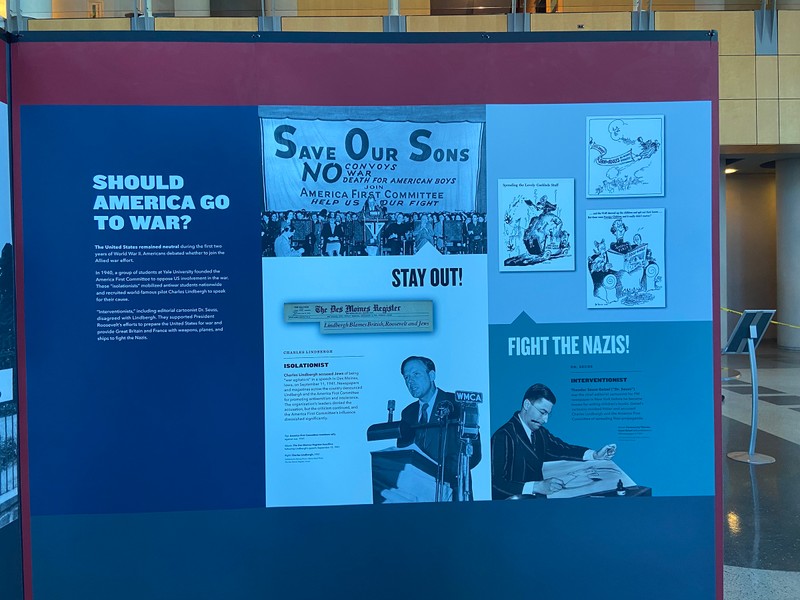Should Americans Go to War? (Americans and the Holocaust)
Introduction
Author-Uploaded Audio
Should Americans Go to War? (Americans and the Holocaust)
Text-to-speech Audio
From 1939 to 1941, there was a public debate over whether the United States should go to war, should just support Great Britain and France (before France was defeated), or should stay out entirely. The America First organization, created by college students, quickly gained 800,000 members and argued that the United States should focus on defending the United States, not going to war in Europe. Charles Lindbergh, the famous pilot and one of the most famous men in America, was the main spokesman for America First. During one speech he made antisemitic statements, blaming the American Jewish community for supposedly pushing the United States to enter the war, and was condemned nationwide for what he said. Do you recognize the artist over here? Dr. Seuss was a political cartoonist at the time and drew dozens of cartoons about Lindbergh and America First, accusing Lindbergh in this cartoon of spreading Nazi propaganda.
Images

Backstory and Context
Text-to-speech Audio
Metropolitan Library System is one of 50 U.S. libraries selected to host AMERICANS AND THE HOLOCAUST, a traveling exhibition from the U.S. Holocaust Memorial Museum that examines the motives, pressures, and fears that shaped Americans’ responses to Nazism, war, and genocide in Europe during the 1930s and 1940s.
The Americans and the Holocaust exhibit will be on display at the Downtown Library, along with a series of related special events from Thursday, January 5 to Sunday, February 12.
Based on extensive new research of that period, Americans and the Holocaust addresses important themes in American history, exploring the many factors — including the Great Depression, isolationism, xenophobia, racism, and antisemitism — that influenced decisions made by the U.S. government, the news media, organizations and individuals as they responded to Nazism. This exhibition will challenge the commonly held assumptions that Americans knew little and did nothing about the Nazi persecution and murder of Jews as the Holocaust unfolded.
Drawing on a remarkable collection of primary sources from the 1930s and ’40s, the exhibition focuses on the stories of individuals and groups of Americans who took action in response to Nazism. It will challenge visitors to consider the responsibilities and obstacles faced by individuals — from Franklin Delano Roosevelt to ordinary Americans — who made difficult choices, sought to effect change, and, in a few cases, took significant risks to help victims of Nazism even as rescue never became a government priority.
Americans and the Holocaust was made possible by the generous support of lead sponsor Jeannie & Jonathan Lavine. Additional major funding was provided by the Bildners — Joan & Allen z”l, Elisa Spungen & Rob, Nancy & Jim; and Jane and Daniel Och. The Museum's exhibitions are also supported by the Lester Robbins and Sheila Johnson Robbins Traveling and Special Exhibitions Fund, established in 1990.
Sources
United States Holocaust Memorial Museum. Accessed January 5th, 2023. https://www.ushmm.org/.
American Library Association. Accessed January 5th, 2023. https://www.ala.org/.
